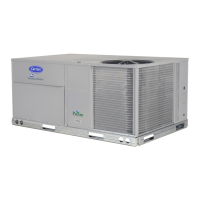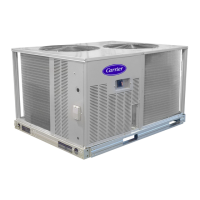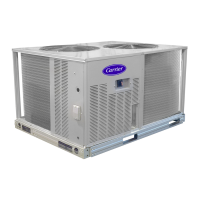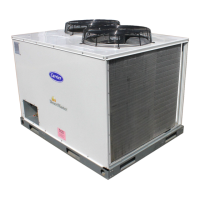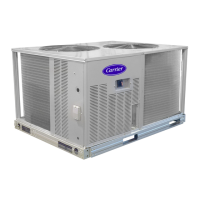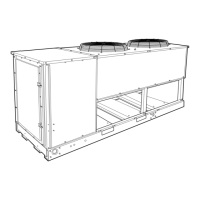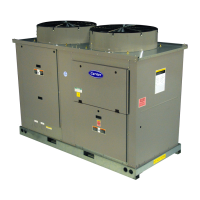39
Hot Gas Bypass Valve Adjustments —
Refer to Fig. 32 for a unit piping schematic with factory
option Hot Gas Bypass control.
The suction pressure regulating valve is located between
the unit’s c ompressor discharge line and the
desuperhea ting tank. A suction pressure tube is connected
between the regulating valves and the unit suction line.
This valve is factory set to begin to open as suction
pressure drops below 109 psig (752 kPa). T his valve ca n
be adjusted by removing the cover bolt on the valve t o
expose the Allen key socket. One turn of this stem
provides a 5 psig (34 kPa) change in valve opening
setting. CW turn reduces the opening setting. CCW turn
incre ases the opening setting. MAXIMUM CCW
adjustment is one turn.
The factory setting is designed to provide a longer run
time during first stage c ooling operation by beginning to
open at approxima tely 36_F(2_C) evaporat or saturate d
suction temperature as space load approaches satisfaction.
This extended run time will provide additional
dehumidification effect.
Comfort Alert Diagnostic Module
The Comfort Alert Diagnostic Module (CADM ) monitors
and analyzes data from the Copeland Scroll three- ph as e
compressor and the thermostat demand. The CADM also
prov id es a 3-minute anti-r ecycle time delay to compr es s or
cycling. Each compressor has a separate CADM module.
The CADM detects causes for electrical and system
related failures without any sensors. Flashing LEDs
communicate the Alert codes to guide service technicians
in accurately and quickly troubleshooting the system and
determining root cause for the failure.
Inputs to the CADM inc lude 24-vac power, thermostat Y1
or Y2, compressor contac tor coil (common side) and
compressor power leads (from the compressor contactor).
Input Te r m i n a l Voltage
Control
Power
R 24-V
Control
Common
C 24-V
Cooling Y 24-V
Contactor
Coil
P 24-V
Line A T1 Line
Line B T2 Line
Line C T3 Line
Control of the compressor conta ctor coil is through a
normally-closed (power on t he module) conta ct between
terminals P and C.
Communications of status and alert conditions is through
three LEDs located on the top edge of the module housing
(see Fig. 36): POWER (green), ALERT (yellow), and
TRIP (red).
The POWER LED indica tes the presence of control power
to the CADM.
The ALERT LED indicates an abnormal condition exists
in the system through a flash code. The ALERT LED will
blink a number of times consecutively, pause and the
repea t the process. The number of blinks, de fined in Table
12, correlates t o a particular abnormal condition;
troubleshooting tips are provided for each Alert code.
Reset of the ALERT may be automatic or manual. If the
fault condition causing the Alert is self-corrected, the
Alert code will be removed and the CADM wil l
automatically reset and allow the system to restart
normally. Manual reset requires that main power to the
38AU unit be recycled after the cause for the Alert
condition has been detected and corrected.
POWER
(GRN)
ALERT
(YEL)
TRIP
(RED)
C10086
Fig. 36 -- CADM Housing/LED Locations
The TRIP LED indicates either a time-delay period is
current ly active (RED LED is blinking) or the module has
locke d out the compressor (RED LED is on steady). A
lockout condition will occur when t he CADM detects a
thermostat demand at input Y but there is no power at the
compressor line terminals T1 or T2 or T 3. This lockout
can occur due to a safety switch (L PS or HPS) opening
and de-energizing the compressor contac tor, the
compressor-motor interna l overload opens, or other
internal power interruption has occurred. Reset of the
TRIP LED requires that unit main power be recycled a fter
the loss of power to the compressor condition has been
detected and corrected.
Simultaneous Blinking of YELLOW and RED LEDs
indicates control power input to the CADM is l ow. Check
control circuit transformer and wiring.
Troubleshooting the CADM Wiring – Flashing LEDs also
indicate wiring problems to the CADM. See Ta ble 13 for
discussion of additional LED flash codes and
troubleshooting instructions.
38AU

